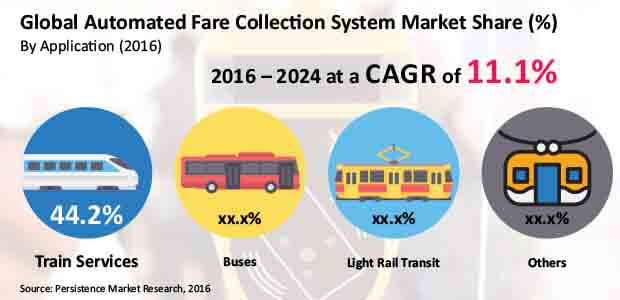Automated Fare Collection System Market Segmented By Hardware, Central Computer System, Station Computer System, Station Equipment, Software, Services System component for Bus Rapid Transit, Light Rail Transit, Train
Industry: Semiconductor Electronics
Published Date: March-2017
Format: PPT*, PDF, EXCEL
Delivery Timelines: Contact Sales
Number of Pages: 230
Report ID: PMRREP6457
Automated fare collection is a solution that automates fare collection or ticketing system in the transportation industry. This solution improves efficiency of ticketing system and transaction rate. Installation of automated fare collection systems enables transport authorities to offer enhanced services to end users. Integration of advanced technologies such as electronic payment, contactless technology, and smart card with automated fare collection system has reduced costs associated with manual ticketing systems in the transportation industry.
In 2017, the global automated fare collection system market is estimated to be valued at nearly US$ 6,000 Mn. By 2024 end, the global automated fare collection system market is expected to reach nearly US$ 12,000 Mn, increasing at a CAGR of 11.1% during the forecast period. Global automated fare collection system market is forecast to represent incremental $ opportunity of nearly US$ 7,000 Mn between 2016 and 2024.
In automated fare collection systems, there is no need for ticket counters, thereby increasing the convenience and saving time for travelers. Even for transport authorities, due to such automated solutions, there is an ease of operation in terms of ticket distribution, checking and also aids in cost minimization.
Due to such factors, various transit authorities are increasingly adopting automated fare collection solutions. An example of automated fare collection system is the smartcard. Smartcards systems make the fare payment faster and it is easy for the commuters to operate. Fare payment transactions through these technologies are three to five times faster than dropping tokens into acceptors or manual paying for the tickets.
Implementation cost of automated fare systems may dissuade transport authorities from adopting the technology and it can be economically impractical for authorities to offer services to a small number of commuters. These factors are expected to adversely hamper demand for the technology over the forecast period.
Implementation of the technology involves installation of a number of hardware and software components such as fare gates, cards, handheld devices, station computer systems, central computer systems, mobile application software, integration software etc. and these are likely to incur high initial costs of setup and deployment.
Upcoming transit infrastructure projects in emerging and mature economies represent potential opportunities for automated fare collection solution providers. In addition, opportunity for providing support services during and after installation of the system will present itself as more and more transit companies adopt the technology.
India’s 100 Smart City project is set to use different modes of transportation involving Metro projects, Monorail, Light Rail Transit (LRT), Bus Rapid Transit (BRT), and Metrino driverless pods. These projects are expected to comprise installed automated fare systems because a large number of commuters are expected to use these services.
In terms of revenue, the train segment is projected to be the most attractive segment in the global automated fare collection system market during the forecast period. The light rail transit segment is expected to register high Y-o-Y growth rates throughout the forecast period. In terms of value, the light rail transit segment is expected to register a CAGR of 12.5% during the forecast period. The train segment accounted for a relatively high value share, and was valued at more than US$ 2,000 Mn in 2015. This segment is expected to remain dominant in terms of revenue throughout the forecast period.

Mobile apps to provide enhanced user experience
Transit authorities across the globe focus on targeting smartphone users via mobile apps in order to provide enhanced user experience and improved transport services. In November 2015, Cubic Corporation launched Ventra Mobile App for Chicago Transit Authority’s (CTA) commuter rail – Metra and suburban bus operator - Pace. The app enables commuters to book Chicago’s transit services via smartphones and has aided in automating its transit fare collection. In September 2011, Thales Group launched live ticketing app for android phones for online ticket booking.
| Attribute | Details |
|---|---|
|
By system component |
|
|
By application |
|
|
By End users |
|
|
By Region |
|
The final section of the report provides the global automated fare collection system market structure and a detailed competition landscape with company market share and performance, to provide report audiences with a dashboard view of key players operating in the global automated fare collection system market along with their business strategies. This section is intended to enable clients to assess strategies deployed by market leaders and help them develop effective strategies accordingly.
To know more about delivery timeline for this report Contact Sales
